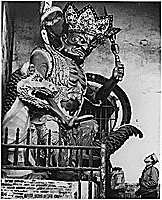The Period of Revolution
(1912 – 1949)
Cowed by foreign powers, China’s imperial rule crumbled. A republic was formed and a president elected. Four years later the president declared himself emperor, and civil war erupted. Reform leaders like Sun Yat-sen, Chiang Kai-shek, and Mao Tse-tung would battle old warlords and each other through this period as the country strained to avoid foreign domination.
China had balked at entering the modern world. Japan, however, looked enviously upon the resources of the Asian continent and considered China weak. By the end of World War I, Japan was entrenched firmly in Manchuria, Mongolia, and China’s Shandong province.
The United States was the other emerging Pacific power. It had long felt sympathetic toward the Chinese people, both because of their plight and the potential of their markets. China, in turn, looked to the United States to check foreign aggression. While Washington tried to reign in Japan’s Asian design, there was little America could do with a limited military and economic presence. In 1921-22, an international conference aiming to limit the world’s navies was held in Washington. The resulting Nine Powers Treaty (also signed by Japan) reaffirmed America’s Open Door policy towards China.
While also recognized by Japan, Tokyo continued to eye China’s vast resources and, by 1937 China and Japan were at war. President Franklin Roosevelt responded with a series of boycotts and froze Japan’s American assets, since America was ill equipped for war. Meanwhile the United States provided Chiang’s forces with financial aid. Once the United States declared war following Japan’s attack on Pearl Harbor, American advisors and aid flowed more steadily into China.
While the Nationalists and Communists at first cooperated against Japan, they soon split. Lead by Mao Tse-tung, the Communists proved very effective at gaining the support of China’s millions of peasants. The Nationalists, occupied at war’s end with repatriating almost three million Japanese and blamed by many for an economy devastated by war, were very unpopular. Four years of fighting between Communists and Nationalists followed the defeat of Japan. When it was over in 1949, the Nationalists had fled to Taiwan, and Mao ruled China.
